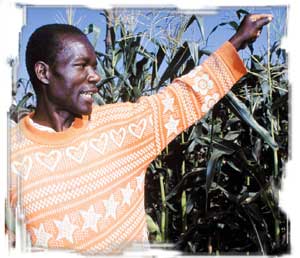CIMMYT E-News, vol 3 no. 9, September 2006
 Farmers participate in a significant portion of CIMMYT research and technology testing, according to center researchers, and the scientists believe this makes their efforts more effective.
Farmers participate in a significant portion of CIMMYT research and technology testing, according to center researchers, and the scientists believe this makes their efforts more effective.
The combined budgets of 19 CIMMYT projects cited by their principal investigators in a 2004 survey as including participatory research components exceeded US$9 million—roughly a quarter of the center’s total budget at the time. “Not all that money was spent on participatory activities, but the figure bespeaks a significant investment,” says Nina Lilja, Agricultural Economist in the on Participatory Research and CGIAR Systemwide Program Gender Analysis for Technology Development and Institutional Innovation (PRGA Program).
This conclusion was one outcome of a study on participatory research at CIMMYT by Lilja and Mauricio Bellon, Director, Diversity for Livelihoods Program, International Plant Genetic Resources Institute (IPGRI), and former Human Ecologist at CIMMYT. “Nearly all respondents felt that the use of participatory approaches had been worthwhile and most believed participatory methods had added value to the research,” says Lilja. “In support of this, many respondents provided evidence of project achievements through use of participatory approaches.”
Participatory research—particularly where farmers help evaluate and promote new crop varieties or farming practices—have been used increasingly in CIMMYT research in recent years. This study represents the first-ever analysis of participatory approaches, from the perspective of center researchers. Through the 2004 survey, the scientists reported on projects they considered as having a participatory component. The range of the study was broad: there was great variation in the types and characteristics of participatory research for which researchers provided information. The survey allowed characterization of the projects, but not further critical analysis of the quality or the appropriateness of the methods applied nor an objective assessment of impacts. Information was received for 19 projects from 18 scientists—15 male, 3 female; 5 social scientists, 13 biophysical scientists. Sixteen of the projects involved farmer-participatory research; three targeted national-program scientists and seed agronomists. Most of the projects covered work in sub-Saharan Africa and Asia; only two had activities in Latin America. About a third of the projects involved participatory testing of crop varieties or production practices; the remainder involved focus group activities or stakeholder meetings.
The issues most frequently addressed via participatory methods related to increasing productivity and understanding farmers’ needs and constraints. “Participatory research at CIMMYT was largely of the functional type—that is, aimed at improving the efficiency and relevance of the research, rather than specifically to empower farmers,” says Bellon. “Also, there was an overall lack of awareness of multiple beneficiaries or of differential effects owing to gender. None of the respondents had been trained previously in participatory methods.”
Two major recommendations of this report for adding value to CIMMYT’s participatory research efforts are to (1) create a more conducive environment within the center for scientists to share experiences and learn from each other, and (2) better document outcomes and impacts of the center’s participatory research.
To view or download a copy of the study, click here.
For further information, contact John Dixon (j.dixon@cgiar.org)